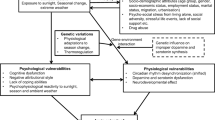Abstract
The main objective of this study was to evaluate the role of climatic parameters and phenomena including the monthly number of dusty/rainy/snowy/foggy days, cloudiness (Okta), horizontal visibility, and barometric pressure (millibar) on major depressive disorder, bipolar, schizophrenia, and schizoaffective admissions. The monthly data related to the number of admissions in Farshchian hospital and climatic parameters from March 2005 to March 2017 were extracted. Random forest regression and dynamic negative binomial regression were used to examine the relationship between variables; the statistical significance was considered as 0.05. The number of dusty/rainy/snowy/foggy days, cloudiness, and the number of days with vision less than 2 km had a significant positive relationship with admissions due to schizophrenia (p < 0.05). Barometric pressure had a negative effect on schizophrenia admissions (p < 0.001). The number of dusty/rainy/snowy/foggy days and cloudiness had a significant effect on schizoaffective admissions (p < 0.05). Bipolar admissions were negatively associated with rainy days and positively associated with dusty days and cloudiness (p < 0.05). The number of rainy/dusty/snowy days and cloudiness had a positive significant effect on major depressive disorder admissions. The results of the present study confirmed the importance of climatic parameter variability for major depressive disorder, bipolar, schizophrenia, and schizoaffective admissions.


Similar content being viewed by others
References
Al-Hurban AE, Al-Ostad AN (2010) Textural characteristics of dust fallout and potential effect on public health in Kuwait City and suburbs. Environ Earth Sci 60:169–181
Anderson CA (2012) Climate change and violence. The encyclopedia of peace psychology. Wiley-Blackwell, Hoboken
Bauer M, Glenn T, Grof P, Rasgon NL, Marsh W, Sagduyu K, Alda M, Murray G, Quiroz D, Malliaris Y (2009) Relationship among latitude, climate, season and self-reported mood in bipolar disorder. J Affect Disord 116:152–157
Breiman L (2001) Random forests. Mach Learn 45:5–32
De Messias EL, Cordeiro NF, Sampaio JJC, Bartko JJ, Kirkpatrick B (2001) Schizophrenia and season of birth in a tropical region: relationship to rainfall. Schizophr Res 48:227–234
Dominiak M, Swiecicki L, Rybakowski J (2015) Psychiatric hospitalizations for affective disorders in Warsaw, Poland: effect of season and intensity of sunlight. Psychiatry Res 229:287–294
Ishwaran H, Kogalur UB, Blackstone EH, Lauer MS (2008) Random survival forests. Ann Appl Stat 2:841–860
Lee H-C, Tsai S-Y, Lin H-C (2007) Seasonal variations in bipolar disorder admissions and the association with climate: a population-based study. J Affect Disord 97:61–69
Liaw A, Wiener M (2002) Classification and regression by randomForest. R News 2:18–22
Liboschik T, Fokianos K, Fried R (2015) tscount: an R package for analysis of count time series following generalized linear models, Universitätsbibliothek Dortmund
Margrethe Christensen E, Knud Larsen J, Gjerris A, Peacock L, Jacobi M, Hassenbalch E (2008) Climatic factors and bipolar affective disorder. Nord J Psychiatry 62:55–58
Mcwilliams S, Kinsella A, O’Callaghan E (2013) The effects of daily weather variables on psychosis admissions to psychiatric hospitals. Int J Biometeorol 57:497–508
Medici CR, Vestergaard CH, Hadzi-Pavlovic D, Munk-Jorgensen P, Parker G (2016) Seasonal variations in hospital admissions for mania: examining for associations with weather variables over time. J Affect Disord 205:81–86
Messias E, Mourao C, Maia J, Campos JPM, Ribeiro K, Ribeiro L, Kirkpatrick B (2006) Season of birth and schizophrenia in Northeast Brazil: relationship to rainfall. J Nerv Ment Dis 194:870–873
O’Hare C, O’Sullivan V, Flood S, Kenny RA (2016) Seasonal and meteorological associations with depressive symptoms in older adults: a geo-epidemiological study. J Affect Disord 191:172–179
QUALITY, I. O. M. C. O. T. E. O. C. C. O. I. A. & HEALTH P (2011) Climate change, the indoor environment, and health. National Academies Press
Sarran C, Albers C, Sachon P, Meesters Y (2017) Meteorological analysis of symptom data for people with seasonal affective disorder. Psychiatry Res 257:501–505
Shiloh R, Shapira A, Potchter O, Hermesh H, Popper M, Weizman A (2005) Effects of climate on admission rates of schizophrenia patients to psychiatric hospitals. Eur Psychiatry 20:61–64
Talaei A, Hedjazi A, Rezaei Ardani A, Fayyazi Bordbar MR, Talaei A (2014) The relationship between meteorological conditions and homicide, suicide, rage, and psychiatric hospitalization. J Forensic Sci 59:1397–1402
Wang S, Zhang X, Xie M, Zhao D, Zhang H, Zhang Y, Cheng Q, Bai L, Su H (2018) Effect of increasing temperature on daily hospital admissions for schizophrenia in Hefei, China: a time-series analysis. Public Health 159:70–77
Welham J, Davies G, Auliciems A, McGrath J (2000) Climate, geography, and the search for candidate, nongenetic, risk factors for schizophrenia. Int J Ment Health 29:79–100
WHO (2018) Available: http://www.who.int/whr/2001/media_centre/press_release/en/ [Accessed]
Yang W, Mu L, Shen Y (2015) How we can use twitter data to better understand weather-related depression. USApp–American politics and policy blog
Acknowledgements
We would like to thank the Vice-Chancellor of Research and Technology, Hamadan University of Medical Sciences, for the approval and support of the study.
Author information
Authors and Affiliations
Corresponding author
Ethics declarations
Conflict of interest
The authors declare that they have no conflict of interest.
Rights and permissions
About this article
Cite this article
Tapak, L., Maryanaji, Z., Hamidi, O. et al. Investigating the effect of climatic parameters on mental disorder admissions. Int J Biometeorol 62, 2109–2118 (2018). https://doi.org/10.1007/s00484-018-1605-4
Received:
Revised:
Accepted:
Published:
Issue Date:
DOI: https://doi.org/10.1007/s00484-018-1605-4




